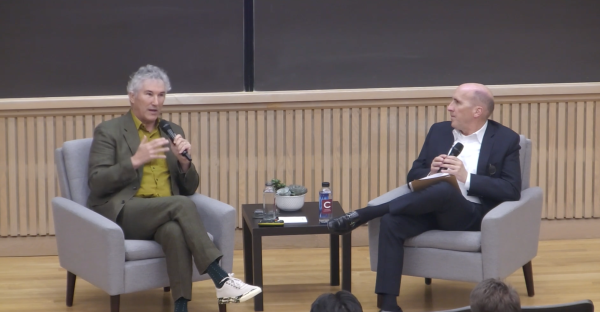Rowe Considers Upsides of Nuclear Technology
On Friday, February 10, Dr. Charlotte Rowe discussed the global history of nuclear testing and treaties. Assistant Professor of Geology Aubreya Adams introduced Rowe to the audience, fascinated by Rowe’s scientific and artistic passions. Dr. Charlotte Rowe attended New Mexico Institute of Mining and Technology where she started out as a music major, but, in her third year, decided to major in geology. She received her master’s degree in geophysics from the University of Alaska and then returned to New Mexico Tech to receive her PhD. In between playing piano and tending to her horses, Rowe works as a geophysicist and seismologist at the Los Alamos National Laboratory.
Although Dr. Rowe was discussing a complex topic, she maintained a light and humorous tone, disclosing that her presentation would not involve the “eye candy” that most people expect when hearing about nuclear weapons; rather, her presentation would be “nerdier.”
She started by introducing the first and only nuclear attack in world history: the atomic bombings of Hiroshima and Nagasaki. The United States dropped two atomic bombs during World War II in order to secure the surrender of Japan. 120,000 people immediately died, and thousands died later from radiation. Since then, most of the global community has tried to halt the use of nuclear weapons.
Although the atomic bombings of Hiroshima and Nagasaki were the only nuclear weapons used for warfare, testing still occurred around the world. Rowe provided a comprehensivedescription of different forms of testing,
including atmospheric and oceanic.
Rowe explained the history of nuclear treaties in great depth. The Limited Test Ban Treaty, or the LTBT, was signed in Moscow on August 5, 1963 and banned the use of nuclear weapons in the atmosphere, outer space, and underwater, promoting the use of underground testing. Not only did the LTBT increase awareness of the effects of nuclear testing, but it also created a stronger national bond, bringing its signatories together under a communal understanding of public safety and environmental issues.
After LTBT, nuclear testing dropped dramatically, and by the early nineties, almost all nations stopped nuclear testing altogether. Dr. Rowe brought to light the ways in which nuclear testing may be useful outside of warfare. She mentioned “Peaceful Nuclear Testing,” a U.S. program implemented for civilian purposes. Nuclear testing could be used for large-scale excavation and quarrying, which would be advantageous in construction projects, as well as underground engineering, which would mostly involve fracking.
One Colgate student who attended the lecture, first-year Kerianne Adler, was fascinated to discover that nuclear weapons had other capabilities besides
obliterating another nation.
“I never would have guessed that nuclear testing served a function for civilians. It’s hard to fathom that a weapon of mass destruction can also help construct highways and canals,” Adler said.
Dr. Rowe explained how nuclear testing was multifaceted–it promoted weapon development, advanced weapon safety, prompted risk assessment and escape strategies, and prolonged technical expertise–after the Comprehensive Test Ban Treaty (CTBT), younger scientists today do not have first-hand testing experience, so they have to rely on the retired or deceased scientists who were able to design and work hands-on with nuclear weapons.
Dr. Charlotte Rowe’s passion and prowess were most obvious when she explained seismic monitoring. She tagged on a quick “yay” after stating that she would move on to describe seismic monitoring stations. With seismic monitoring, from a distance, she explained how we can better understand phenomena that happened near the explosion’s source. And with seismic interpretation, we can identify similar seismic phases between different explosions and then use that information to characterize possible events in the future.
Rowe debunked the notion that nuclear and warfare come hand in hand. Rowe is not on the weapons side of the lab; rather, she studies seismic signal processing methods and determines where nuclear and volcanic explosions occur. In a single presentation, she was able to elaborate on the entire history of nuclear testing and treaties through modern day.




